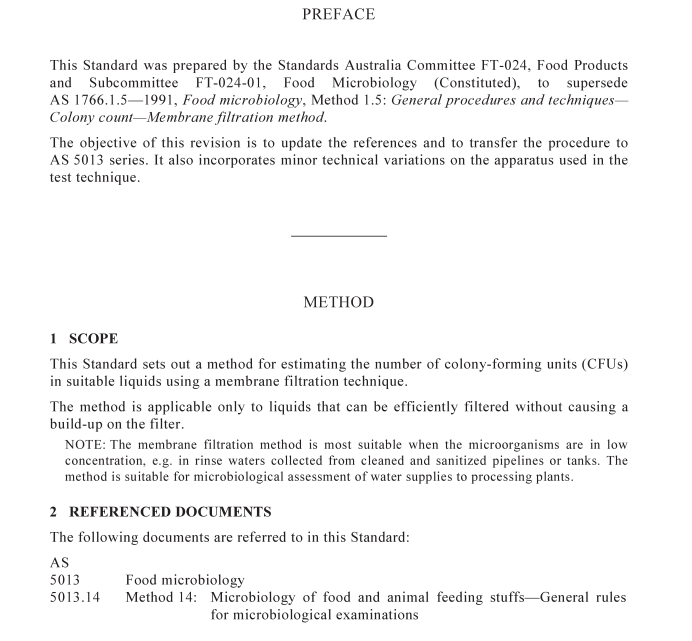AS 5013.14.2 pdf download – Food microbiology Method 14.2: General procedures and techniques—Colony count—Membrane filtration method

AS 5013.14.2 pdf download – Food microbiology Method 14.2: General procedures and techniques—Colony count—Membrane filtration method
The method involves passing a liquid sample through a membrane of known physicalproperties. Microorganisms in the sample are retained on the membrane which is thenplaced on a filter pad saturated with liquid medium, or on solid medium, and incubated.Colonies, corresponding to the viable organisms collected on the filter, are then counted.
4 DILUENTS AND CULTURE MEDIA
The diluents and culture media shall be as specified in the relevant methods of AS 5013according to the product under examination and the microorganisms to be enumerated.
Where the medium does not give rise to a good contrast for the colonies developed, a staincomprising 0.0l percent aqueous solution of malachite green oxalate is required.
5 APPARATUS
The following apparatus is required:(a)Membrane filtration apparatus.
NOTE: Various types of apparatus suitable for the membrane filtration method are availablecommercially in Australia.
(b)Grid-mark membrane filters of 47 mm to 50 mm diameter to fit the apparatus and
having a pore size appropriate to the organism or organisms to be assessed.The usualsize for water is 0.45 um.
NOTE: Sterile membrane filters are commercially available.
(c)A filter flask of capacity appropriate to the volume of liquid to be filtered.(d)A source of vacuum.
(e)Forceps that will not damage the membrane.(fPetri dishes.
(g)Graduated measuring cylinders,where required, suitable for measuring the volume of
sample to be filtered.
(h)Graduated pipettes.(i)A tally counter.j)A suitable incubator.
(k)Non-toxic absorbent filter pads of diameter either equal to or slightly greater than the
diameter of the membrane filters with which they are to be used.
1 Pasteur pipettes.
NOTE: Items (k) and (1) above are only required where the nutrient pad technique is to beused.
6PREPARATION OF APPARATUS AND MATERIALS6.1Sterilization
The apparatus and materials shall be sterilized as follows:
(a) Wrap the base of the membrane filtration apparatus,with the membrane support in
position,in kraft paper or other suitable material. Wrap the filter funnel separatelyand sterilize the contents of both parcels by autoclaving.
NOTE: Some commercial unit can be sterilized fully assembled.
6.2 Medium
6.2.1 Liquid medium
Where used, a filter pad shall be soaked with liquid medium as follows:(a) Using forceps, place a filter pad in a Petri dish.
(b)Add sufficient liquid medium to saturate the pad and to result in a small excess.NOTE: A 5 cm (in diameter) filter pad will require 2.0 mL to 2.5 mL of medium.6.2.2Solid medium
Where a solid medium is used, the plates should be prepared as follows:
(a)Pour sufficient volume of molten medium into a Petri dish to give a depth of
approximately 5 mm. Allow to set.
(b)
As soon as the medium has set, remove excess moisture from the plates by one of thefollowing methods:
(i)Incubate the plates open with the internal surface of the base facing downwards
and with the base resting on the lid, for the minimum time necessary to obtainplates free from condensate, e.g. at 37°C for about 2 h or at 45°C for about l h.Do not dry plates at temperatures above 45C.
(ii) Incubate at 37°C for 16 h in the inverted position with the lids on.If the plates
are not then free of condensate,open them and incubate as described in Step (i)above until dry.
(iii) Other suitable time/temperature regimes.For example, on bench over night.
NOTE:In humid climates either extend drying time or place a tray of desiccant, suchas silica gel, in the base of the drying oven.
7 FILTRATION PROCEDURE
7.1General
The optimum volume of liquid to be used will depend upon the amount of undissolvedsolids in the sample and the expected count.
lf the expected count is high,suitable dilutions of the sample should be made (see Note).Where the expected count is uncertain, it is recommended that two determinations be madeusing two different volumes. In this way, the probability that at least one determination willbe within the range 20 to 80 will be increased.
NOTE: The optimum number of colonies on the filter is about 50 and the volume of samplefiltered should be such that the number of colonies to be counted on the membrane is not greaterthan 80. For example,samples expected to contain less than 80 organisms per 100 mL require thefiltration of at least 100 mL of sample for each test.
7.2 Procedure
The procedure shall be as follows:
NOTE: Where a pre-assembled filtration unit is used,Steps (a) to (c) below are not required.









